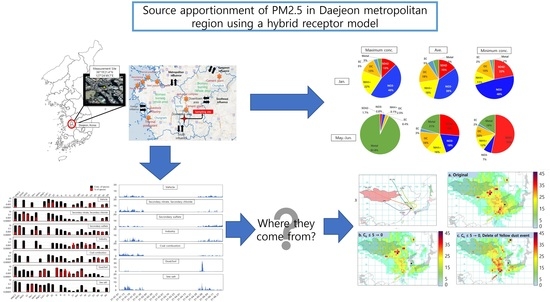Source Apportionment of PM2.5 in Daejeon Metropolitan Region during January and May to June 2021 in Korea Using a Hybrid Receptor Model
Abstract
1. Introduction
2. Experimental Methods
2.1. Sampling Location and Monitoring Site
2.2. PM2.5 Sampling and Measurement
2.3. Positive Matrix Factorization (PMF)
2.4. Concentration Weight Trajectory (CWT)
3. Result and Discussion
3.1. Chemical Composition of PM2.5
| Jan. 2021 | May to Jun. 2021 | |||||||||||
|---|---|---|---|---|---|---|---|---|---|---|---|---|
| Data | Ave. | Med. | Std. | Max. | Min. | Data | Ave. | Med. | Std. | Max. | Min. | |
| PM2.5 | 743 | 25 | 22 | 14 | 104 | 1 | 1460 | 22 | 19 | 19 | 183 | 1 |
| SO42− | 540 | 3.29 | 2.74 | 2.09 | 11.8 | 0.33 | 890 | 5.01 | 4.89 | 3.01 | 15.8 | 0.16 |
| NO3− | 540 | 8.32 | 7.05 | 5.96 | 42.2 | 0.55 | 890 | 3.45 | 1.83 | 4.39 | 29.5 | 0.07 |
| Cl− | 540 | 0.75 | 0.67 | 0.41 | 2.92 | 0.1 | 866 | 0.16 | 0.07 | 0.23 | 1.44 | 0.005 |
| Anions | 540 | 12.3 | 10.1 | 7.58 | 56.1 | 1.56 | 890 | 8.61 | 7.31 | 6.76 | 45.9 | 0.31 |
| Anions /PM2.5 | 540 | 0.43 | 0.35 | 0.26 | 1.93 | 0.05 | 888 | 0.37 | 0.36 | 0.15 | 1.19 | 0.013 |
| Na+ | 419 | 0.13 | 0.09 | 0.1 | 0.63 | 0.02 | 935 | 0.1 | 0.06 | 0.13 | 1.32 | 0.005 |
| NH4+ | 540 | 3.9 | 3.21 | 2.68 | 19.3 | 0.4 | 962 | 3.07 | 2.64 | 2.35 | 14.9 | 0.014 |
| K+ | 291 | 0.16 | 0.13 | 0.13 | 0.9 | 0.01 | 847 | 0.16 | 0.13 | 0.13 | 0.93 | 0.005 |
| Mg2+ | 497 | 0.09 | 0.03 | 0.21 | 2.58 | 0.01 | 791 | 0.05 | 0.02 | 0.12 | 0.85 | 0.005 |
| Ca2+ | 539 | 0.33 | 0.13 | 0.74 | 7.79 | 0.01 | 949 | 0.26 | 0.09 | 0.79 | 6.81 | 0.006 |
| Cations | 540 | 4.5 | 3.81 | 2.98 | 20.1 | 0.5 | 969 | 3.59 | 3.13 | 2.44 | 15.2 | 0.09 |
| Cations /PM2.5 | 540 | 0.16 | 0.13 | 0.1 | 0.72 | 0.02 | 968 | 0.15 | 0.15 | 0.06 | 0.45 | 0.01 |
| A+C /PM2.5 | 540 | 0.58 | 0.48 | 0.36 | 2.65 | 0.07 | 968 | 0.49 | 0.49 | 0.22 | 1.64 | 0.016 |
| OC | 737 | 3.81 | 3.34 | 2.07 | 12.4 | 0.92 | 1385 | 2.93 | 2.34 | 2.08 | 12.9 | 0.14 |
| EC | 737 | 1.03 | 0.81 | 0.73 | 4.21 | 0.11 | 1300 | 0.51 | 0.45 | 0.27 | 1.71 | 0.02 |
| Carbon | 737 | 4.84 | 4.19 | 2.74 | 16.6 | 1.18 | 1392 | 3.39 | 2.85 | 2.32 | 14 | 0.03 |
| Carbon /PM2.5 | 737 | 0.17 | 0.14 | 0.09 | 0.57 | 0.04 | 1388 | 0.17 | 0.16 | 0.08 | 0.82 | 0.01 |
| Element | 738 | 1.04 | 0.64 | 1.16 | 8.53 | 0.12 | 1430 | 3.97 | 2.66 | 7.96 | 85.2 | 0.031 |
| Element /PM2.5 | 738 | 0.036 | 0.02 | 0.04 | 0.29 | 0.004 | 1426 | 0.149 | 0.13 | 0.07 | 0.81 | 0.01 |
3.2. Source Apportionment by PMF
3.3. Regional Contribution
4. Conclusions
Supplementary Materials
Author Contributions
Funding
Institutional Review Board Statement
Informed Consent Statement
Data Availability Statement
Acknowledgments
Conflicts of Interest
References
- Han, J.S.; Moon, K.J.; Kim, Y.J. Identification of potential sources and source regions of fine ambient particles measured at Gosan background site in Korea using advanced hybrid receptor model combined with positive matrix factorization. J. Geophys. Res. 2006, 111, D22217. [Google Scholar] [CrossRef]
- Lu, Z.J.; Liu, Q.Y.; Xiong, Y.; Huang, F.; Zhou, J.B. A hybrid source apportionment strategy using positive matrix factorization (PMF) and molecular marker chemical mass balance (MM-CMB) models. Environ. Pollut. 2018, 238, 39–51. [Google Scholar] [CrossRef] [PubMed]
- Park, J.E.; Kim, H.W.; Kim, Y.K.; Heo, J.B.; Kim, S.W.; Jeon, K.H.; Yi, S.M.; Hopke, P.K. Source apportionment of PM2.5 in Seoul, South Korea and Beijing, China using dispersion normalized PMF. Sci. Total Environ. 2022, 833, 155056. [Google Scholar] [CrossRef] [PubMed]
- Anderson, H.R. Air pollution and mortality: A history. Atmos. Environ. 2009, 43, 142–152. [Google Scholar] [CrossRef]
- Miller, K.A.; Siscovick, D.S.; Sheppard, L.; Shepherd, K.; Sullivan, J.H.; Anderson, G.L.; Kaufman, J.D. Long-term exposure to air pollution and incidence of cardiovascular events in women. N. Engl. J. Med. 2007, 356, 447–458. Available online: https://www.nejm.org/doi/full/10.1056/NEJMoa054409 (accessed on 1 October 2022). [CrossRef]
- WHO. Ambient (Outdoor) Air Quality and Health. Fact Sheet No 313. Updated March 2014. 2016. Available online: http://www.who.int/mediacentre/factsheets/fs313/en/ (accessed on 7 November 2016).
- IARC. IARC: Outdoor Air Pollution a Leading Environmental Cause of Cancer Deaths. 2013. Press Release N° 221. Available online: https://www.iarc.fr/en/media-centre/iarcnews/pdf/pr221_E.pdf (accessed on 17 October 2013).
- Brunekreef, B.; Holgate, S. Air pollution and health. Lancet 2002, 360, 1233–1242. Available online: https://dspace.library.uu.nl/bitstream/handle/1874/7410/IVR%203A1%20Brunekreef%20et%20al%20(2002).pdf?sequence=2 (accessed on 1 October 2022). [CrossRef]
- Dockery, D.W.; Stone, P.H. Cardiovascular risks from fine particulate air pollution. N. Engl. J. Med. 2007, 356, 511–513. Available online: http://toxicology.usu.edu/endnote/511.pdf (accessed on 1 October 2022). [CrossRef]
- Ozkaynak, H.; Spengler, J.D. Analysis of health effect resulting from population exposures to acid precipitation precursors. Environ. Health Perspect. 1985, 63, 45–55. Available online: https://www.ncbi.nlm.nih.gov/pmc/articles/PMC1568498/ (accessed on 1 October 2022). [CrossRef]
- WHO. World Health Statistics 2016. Available online: http://www.who.int/gho/publications/world_health_statistics/2016/en/ (accessed on 1 October 2022).
- WHO. World Health Statistics 2021: Monitoring Health for the SDGs, Sustainable Development Goals; WHO: Geneva, Switzerland, 2021; ISBN 978-92-4-002705-3. (electronic version); Licence: CC BYNC-SA 3.0 IGO. [Google Scholar]
- Park, M.B.; Lee, T.J.; Lee, E.S.; Kim, D.S. Enhancing source identification of hourly PM2.5 data in Seoul based on a dataset segmentation scheme by positive matrix factorization (PMF). Atmos. Pollut. Res. 2019, 10, 1042–1059. [Google Scholar] [CrossRef]
- Park, J.M.; Lee, T.J.; Kim, D.S. Improving PMF source reconciliation with cluster analysis for PM2.5 hourly data from Seoul, Korea. Atmos. Pollut. Res. 2022, 13, 101398. [Google Scholar] [CrossRef]
- Han, J.S.; Moon, K.J.; Lee, S.J.; Kim, Y.J.; Ryu, S.Y.; Cliff, S.S.; Yi, S.M. Size-resolved source apportionment of ambient particles by positive matrix factorization at Gosan background site in East Asia. Atmos. Chem. Phys. 2006, 6, 211–223. [Google Scholar] [CrossRef]
- Belis, C.A.; Karagulian, F.; Larsen, B.R.; Hopke, P.K. Critical review and metaanalysis of ambient particulate matter source apportionment using receptor models in Europe. Atmos. Environ. 2013, 69, 94–108. Available online: https://www.sciencedirect.com/science/article/pii/S1352231012010540 (accessed on 1 October 2022). [CrossRef]
- Brown, S.G.; Eberly, S.; Paatero, P.; Norris, G.A. Methods for estimating uncertainty in PMF solutions: Examples with ambient air and water quality data and guidance on reporting PMF results. Sci. Total Environ. 2015, 518–519, 626–635. Available online: https://www.sciencedirect.com/science/article/pii/S004896971500025X (accessed on 1 October 2022). [CrossRef] [PubMed]
- Hwang, I.J.; Kim, D.S. Research trends of receptor models in Korea and foreign countries and improvement directions for air quality management. J. Kor. Soc. Atmos. Environ. 2013, 29, 459–476. Available online: http://www.dbpia.co.kr/Journal/PDFViewNew?id=NODE02230877 (accessed on 1 October 2022). [CrossRef]
- Reff, A.; Eberly, S.I.; Bhave, P.V. Receptor modeling of ambient particulate matter data using positive matrix factorization: Review of existing methods. J. Air Waste Manag. Assoc. 2007, 57, 146–154. Available online: https://www.tandfonline.com/doi/abs/10.1080/10473289.2007.10465319 (accessed on 1 October 2022). [CrossRef]
- Solomon, P.A.; Hopke, P.K.; Froines, J.; Scheffe, R. Key scientific findings and policy- and health-relevant insights from the U.S. EPA’s particulate matter Supersites program and related studies: An integration and synthesis of results. J. Air Waste Manag. Assoc. 2008, 58, S3–S92. Available online: https://search.proquest.com/docview/214375417?pqorigsite=gscholar (accessed on 1 October 2022). [CrossRef]
- Thurston, G.D.; Ito, K.; Lall, R. A source apportionment of U.S. fine particulate matter air pollution. Atmos. Environ. 2011, 45, 3924–3936. Available online: https://www.sciencedirect.com/science/article/pii/S1352231011004596 (accessed on 1 October 2022). [CrossRef]
- Hwang, J.; Hopke, P.K. Estimation of source apportionment and potential source locations of PM2.5 at a west coastal IMPROVE site. Atmos. Environ. 2007, 41, 506–518. [Google Scholar] [CrossRef]
- Hwang, I.H.; Yi, S.M.; Park, J.S. Estimation of Source Apportionment for Filter-based PM2.5 Data using the EPA-PMF Model at Air Pollution Monitoring Supersites. J. Korean Soc. Atmos. Environ. 2020, 36, 620–632. [Google Scholar] [CrossRef]
- Hopke, P.K.; Gao, N.; Cheng, M.D. Combining chemical and meteorological data to infer source areas of airborne pollutants. Chemom. Intel. Lab. Syst. 1993, 19, 187–199. [Google Scholar] [CrossRef]
- Seibert, P.; Kromp-Kolb, H.; Baltensperger, U.; Jost, D.T.; Schwikowski, M.; Kasper, A.; Puxbaum, H. Trajectory analysis of aerosol measurements at high Alpine sites. In Transport and Transformation of Pollutants in the Troposphere; Borrell, P.M., Ed.; Elsevier: New York, NY, USA, 1994; pp. 689–693. [Google Scholar]
- Stohl, A. Trajectory statistics—A new method to establish source receptor relationships of air pollutants and its application to the transport of particulate sulfate in Europe. Atmos. Environ. 1996, 30, 579–587. [Google Scholar] [CrossRef]
- Han, Y.J.; Holsen, T.M.; Hopke, P.K.; Cheong, J.P.; Kim, H.; Yi, S.M. Identification of source locations for atmospheric dry composition of heavy metals during yellow-sand events in Seoul, Korea in 1998 using hybrid receptor models. Atmos. Environ. 2004, 38, 5353–5361. [Google Scholar] [CrossRef]
- Lupu, A.; Maenhaut, W. Application and comparison of two statistical trajectory techniques for identification of source regions of atmospheric aerosol species. Atmos. Environ. 2002, 36, 5607–5618. [Google Scholar] [CrossRef]
- Fan, W.; Qin, K.; Xu, J.; Yuan, L.; Li, D.; Jin, Z.; Zhang, K. Aerosol vertical distribution and sources estimation at a site of the Yangtze River Delta region of China. Atmos. Res. 2019, 217, 128–136. [Google Scholar] [CrossRef]
- Dimitriou, K.; Mihalopoulos, N.; Leeson, S.R.; Twigg, M.M. Sources of PM2.5-bound water soluble ions at EMEP’s Auchencorth Moss (UK) supersite revealed by 3D-Concentration Weighted Trajectory (CWT) model. Chemosphere 2021, 274, 129979. [Google Scholar] [CrossRef]
- Wang, Y.Q.; Zhang, X.Y.; Arimoto, R. The contribution from distant dust sources to the atmospheric particulate matter loadings at XiAn, China during spring. Sci. Total Environ. 2006, 368, 875–883. [Google Scholar] [CrossRef]
- Jeong, U.K.; Kim, J.H.; Lee, H.L.; Jung, J.S.; Kim, Y.J.; Song, C.H.; Koo, J.H. Estimation of the contributions of long range transported aerosol in East Asia to carbonaceous aerosol and PM concentrations in Seoul, Korea using highly time resolved measurements: A PSCF model approach. J. Environ. Monit. 2011, 13, 1905–1918. [Google Scholar] [CrossRef]
- Zachary, M.; Yin, L.; Zacharia, M. Application of PSCF and CWT to Identify Potential Sources of Aerosol Optical Depth in ICIPE Mbita. Open Access Libr. J. 2018, 5, e4487. [Google Scholar] [CrossRef]
- Do, W.G.; Jung, W.S. Estimation of PM10 source locations in Busan using PSCF model. J. Environ. Sci. Int. 2015, 24, 793–806. [Google Scholar] [CrossRef][Green Version]
- Hsu, Y.K.; Holsen, T.M.; Hopke, P.K. Comparison of hybrid receptor models to locate PCB sources in Chicago. Atmos. Environ. 2003, 37, 545–562. [Google Scholar] [CrossRef]
- Carslaw, D. The Openair Manual Open-Source Tools for Analysing Air Pollution Data; University of York and Ricardo Energy & Environment: York, UK, 2019. [Google Scholar]
- National Institute of Environmental Research (NIER). 2020 Annual Report of Intensive Air Quality Monitoring Station, NIER-GP2020-208; NIER: Incheon, Korea, 2021. [Google Scholar]
- Nuhoglu, Y.; Yazici, M.; Nuhoglu, C.; Kam, E.; Adar, E.; Kuzu, L.; Osmanlioglu, A.E. XRF Analysis of Airborne Heavy Meatals and Distribution of Environment in Sivas City Turkey through Dust Samples. In Proceedings of the EurAsia Waste Management Symposium, Istanbul, Turkey, 26–28 October 2020; pp. 26–28. [Google Scholar]
- Rahman, M.S.; Kumar, P.; Ullah, M.; Jolly, Y.N.; Akhter, S.; Karbir, J.; Begum, B.A.; Salam, A. Elemental analysis on surface soil and dust of roadside academic institutions in Dhaka city, Bangladesh and their impact on human health. Environ. Chem. Ecotoxicol. 2021, 3, 197–208. [Google Scholar] [CrossRef]
- National Institute of Environmental Research (NIER). An Estimate of Internal and External Sources Contributing to Ambient Particulate Matter and a Guideline on the Application of Air Quality Receptor Models (II), NIER-SP2016-422; NIER: Incheon, Korea, 2017. [Google Scholar]
- Lee, S.Y.; Hong, J.M.; Cho, Y.S.; Choi, M.J.; Kim, J.H.; Park, S.S.; Ahn, J.Y.; Kim, S.K.; Moon, K.J.; Eck, T.F.; et al. Characteristics of Classified Aerosol Types in South Korea during the MAPS-Seoul Campaign. Aerosol Air Qual. Res. 2018, 18, 2195–2206. [Google Scholar] [CrossRef]
- Filonchyk, M.; Peterson, M. Development, progression, and impact on urban air quality of the dust storm in Asia in March 15-18, 2021. Urban Clim. 2022, 41, 101080. [Google Scholar] [CrossRef]
- Liu, Q.; Liu, Y.; Yin, J.; Zhang, M.; Zhang, T. Chemical characteristics and source apportionment of PM10 during Asian dust storm and non-dust storm days in Beijing. Atmos. Environ. 2014, 91, 85–94. [Google Scholar] [CrossRef]
- Tan, S.C.; Shi, G.Y.; Wang, H. Long-range transports of spring dust storm in Inner Mongolia and impact on the China seas. Atmos. Environ. 2012, 46, 299–308. [Google Scholar] [CrossRef]
- Guo, S.; Hu, M.; Wang, Z.B.; Slanina, J.; Zhao, Y.L. Size-resolved aerosol water-soluble ionic compositions in the summer of Beijing: Implication of regional secondary formation. Atmos. Chem. Phys. 2010, 10, 947–959. [Google Scholar] [CrossRef]
- Seinfeld, J.H.; Pandis, S.N. Atmospheric Chemistry and Physics: From Air Pollution to Climate Change, 3rd ed.; John Wiley and Sons: New York, NY, USA, 2016; Volume 40, p. 26. [Google Scholar]
- Wang, Y.; Zhuang, G.; Zhang, X.; Huang, K.; Xu, C.; Tang, A.; Chen, J.; An, Z. The ion chemistry, seasonal cycle, and sources of PM2.5 and TSP aerosol in Shanghai. Atmos. Environ. 2006, 40, 2935–2952. [Google Scholar] [CrossRef]
- Busra, M.; Karsi, B.; Berberler, E.; Berberler, T.; Aslan, O.; Wenisoy-Karakas, S.; Karakas, D. Correction and source apportionment of vehicle enission factors obtained from Bolu Mountain Highway Tunnel, Turkey. Atmos. Pollut. Res. 2020, 11, 2133–2141. [Google Scholar]
- Hao, Y.; Gao, C.; Deng, S.; Yuan, M.; Song, W.; Lu, Z.; Qiu, Z. Chemical characterization of PM2.5 emitted from motor vehicles powered by diesel, gasoline, natural gas, and methanol fuel. Sci. Total Environ. 2019, 674, 128–139. [Google Scholar] [CrossRef]
- Coufalík, P.; Matoušek, T.; Křůmal, K.; Vojtíšek-Lom, M.; Beránek, V.; Mikuška, P. Content of metals in emissions from gasoline, diesel, and alternative mixed biofuels. Environ. Sci. Pollut. Res. 2019, 26, 29012–29019. [Google Scholar] [CrossRef]
- Cheung, K.L.; Ntziachristos, L.; Tzamkiozis, T.; Schauer, J.J.; Samaras, Z.; Moore, K.F.; Sioutas, C. Emissions of particulate trace elements, metals and organic species from gasoline, diesel, and biodiesel passenger vehicles and their relation to oxidative potential. Aerosol. Sci. Technol. 2010, 44, 500–513. [Google Scholar] [CrossRef]
- Taghvaee, S.; Sowlat, M.H.; Mousavi, A.; Hassanvand, M.S.; Yuesian, M.; Naddafi, K.; Sioutas, C. Source apportionment of ambient PM2.5 in two locations in central Tehran using the Positive Matrix Factorization (PMF) model. Sci. Total Environ. 2018, 628–629, 672–686. [Google Scholar] [CrossRef] [PubMed]
- Chun, M.Y.; Lee, Y.J.; Kim, H.K. Concentration of NH4NO3 in TSP in Seoul Ambient Air. J. Korean Soc. Atmos. Environ. 1994, 10, 130–136. [Google Scholar]
- Son, S.E.; Park, S.S.; Bae, M.A.; Kim, S.T. A study on characteristics of high pollution observed around large scale stationary sources in Chungcheongnam-do province. J. Korean Soc. Atmos. Environ. 2020, 36, 669–687. [Google Scholar] [CrossRef]
- Jr, S.J.G.; Weis, J.; China, S.; Evangelista, H.; Harber, T.H.; Muller, S.; Sampaio, M.; Laskin, A.; Gilles, M.K.; Godoi, R.H.M. Photochemical reactions on aerosols at West Antarctica: A molecular case-study of nitrate formation among sea salt aerosols. Sci. Total Environ. 2021, 758, 143586. [Google Scholar]
- Kim, K.H.; Kim, M.Y. The effects of asian dust on particulate matter fractionation in Seoul, Korea during spring 2001. Chemosphere 2003, 51, 707–721. [Google Scholar] [CrossRef]
- Lee, B.K.; Jun, N.Y.; Lee, H.K. Comparison of particulate matter characteristics before, during, and after Asian dust events in Incheon and Ulsan. Korea Atmos. Environ. 2004, 38, 1535–1545. [Google Scholar] [CrossRef]
- Zhao, Y.F.; Shi, X.Z.; Huang, B.; Yu, D.S.; Wang, H.J.; Sun, W.X.; Oboern, I.; Blomback, K. Spatial distribution of heavy metals in agricultural soils of an industry-based peri-urban area in Wuxi, China. Pedosphere 2007, 17, 44–51. [Google Scholar] [CrossRef]
- Li, Y.; Lin, T.; Hu, L.; Feng, J.; Guo, Z. Time trends of polybrominated diphenyl ethers in east China seas: Response to the booming of PBDE pollution industry in China. Environ. Int. 2016, 92–93, 507–514. [Google Scholar] [CrossRef]
- Cho, J.W. The current situation and prospect of economic cooperation between far eastern Russia and three provinces of northeastern China. Russ. Stud. 2013, 23, 343–373. [Google Scholar]
- Patxi, G.N.; Yusaku, K. Tidal stream energy as a potential continuous power producer: A case study for west Japan. Energy Convers. Manag. 2021, 245, 114533. [Google Scholar]


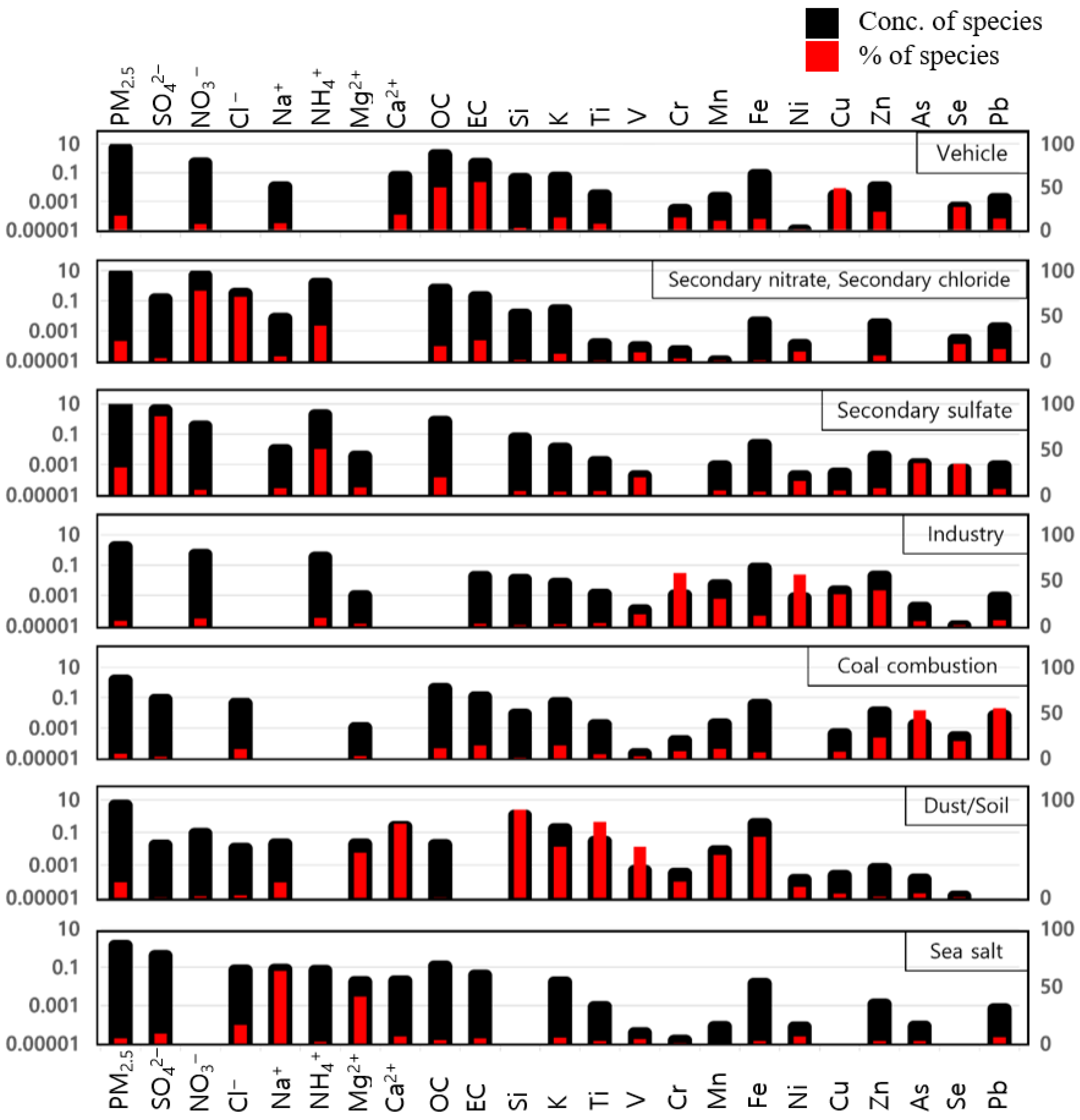
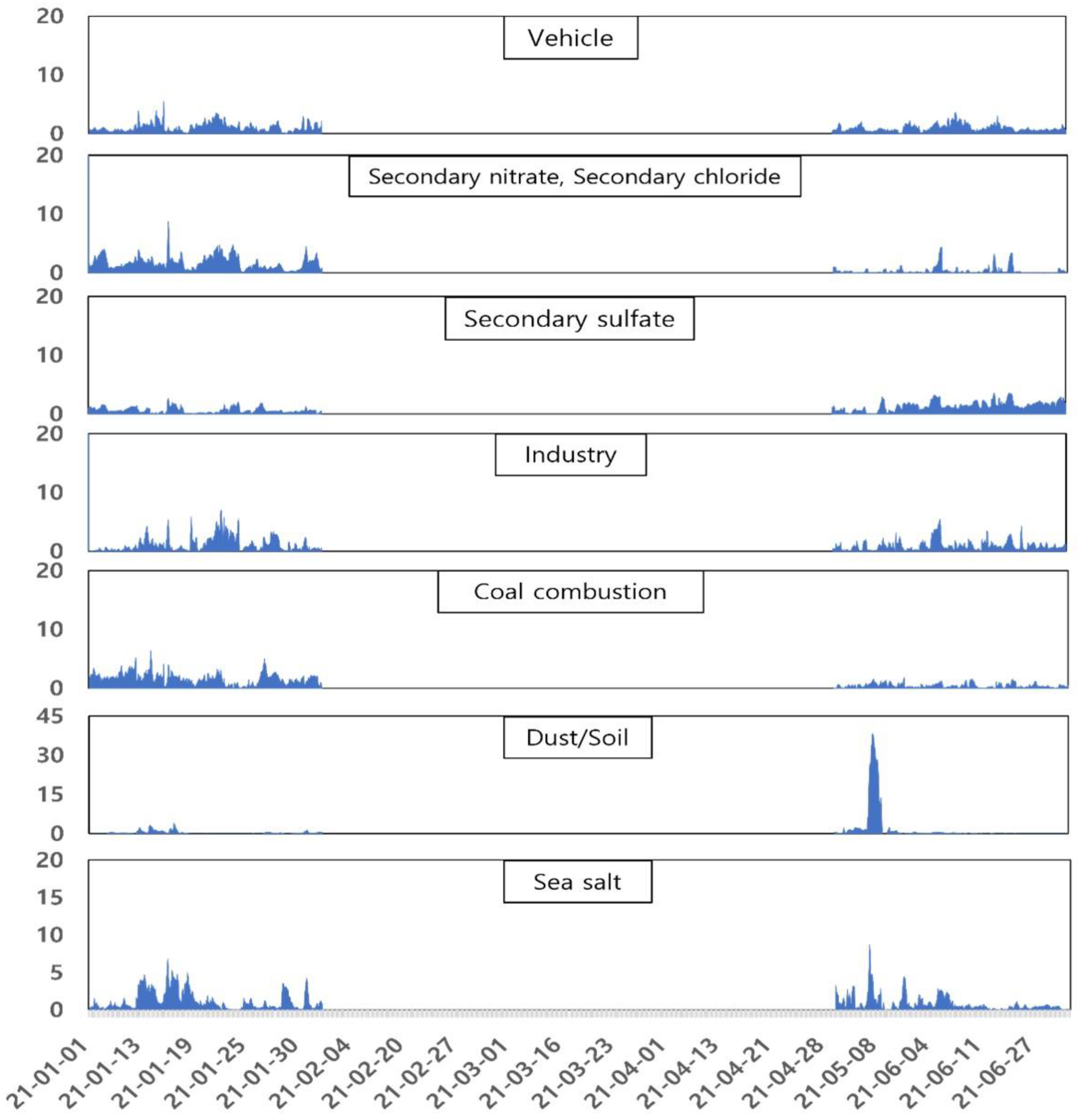

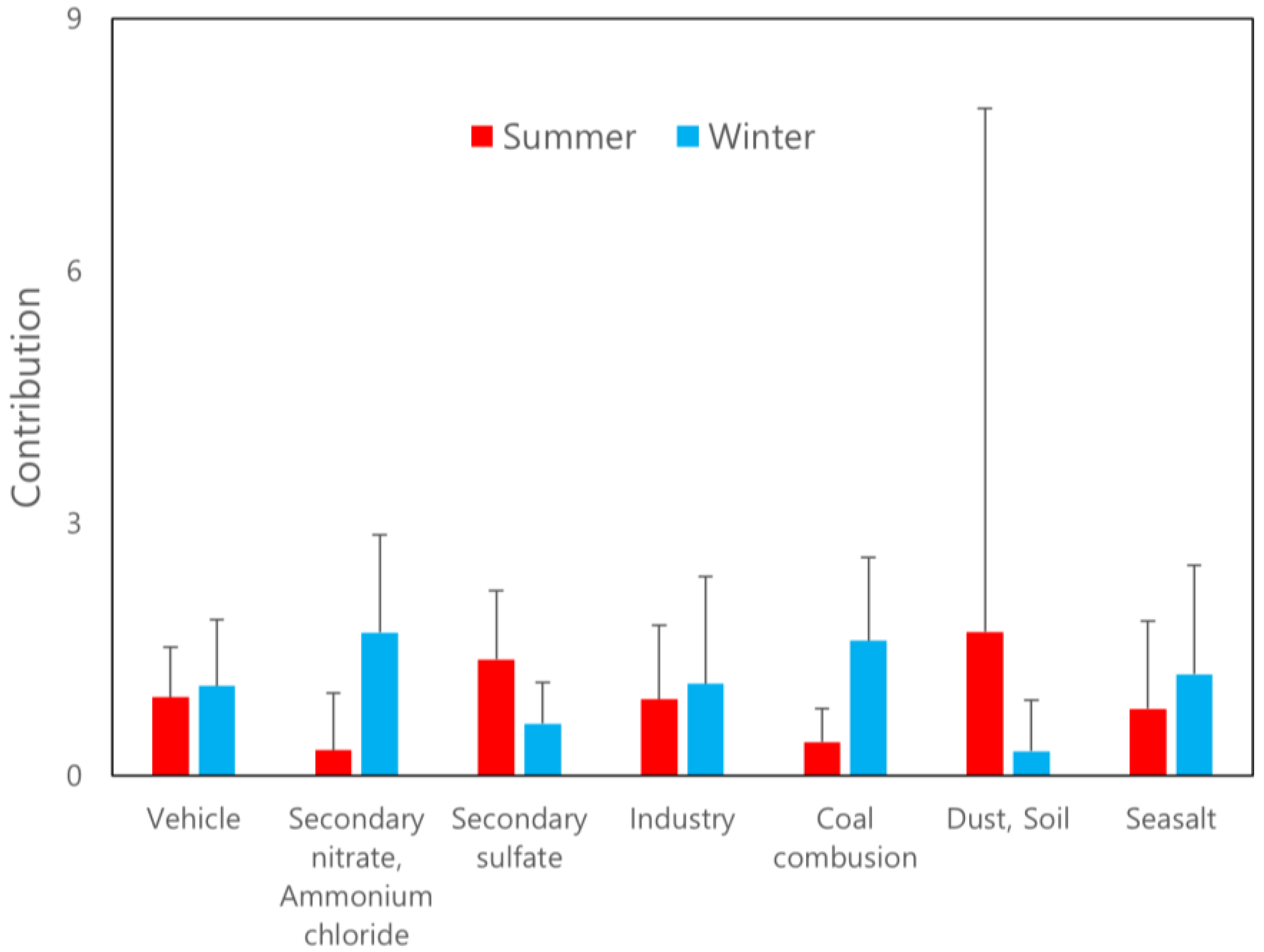
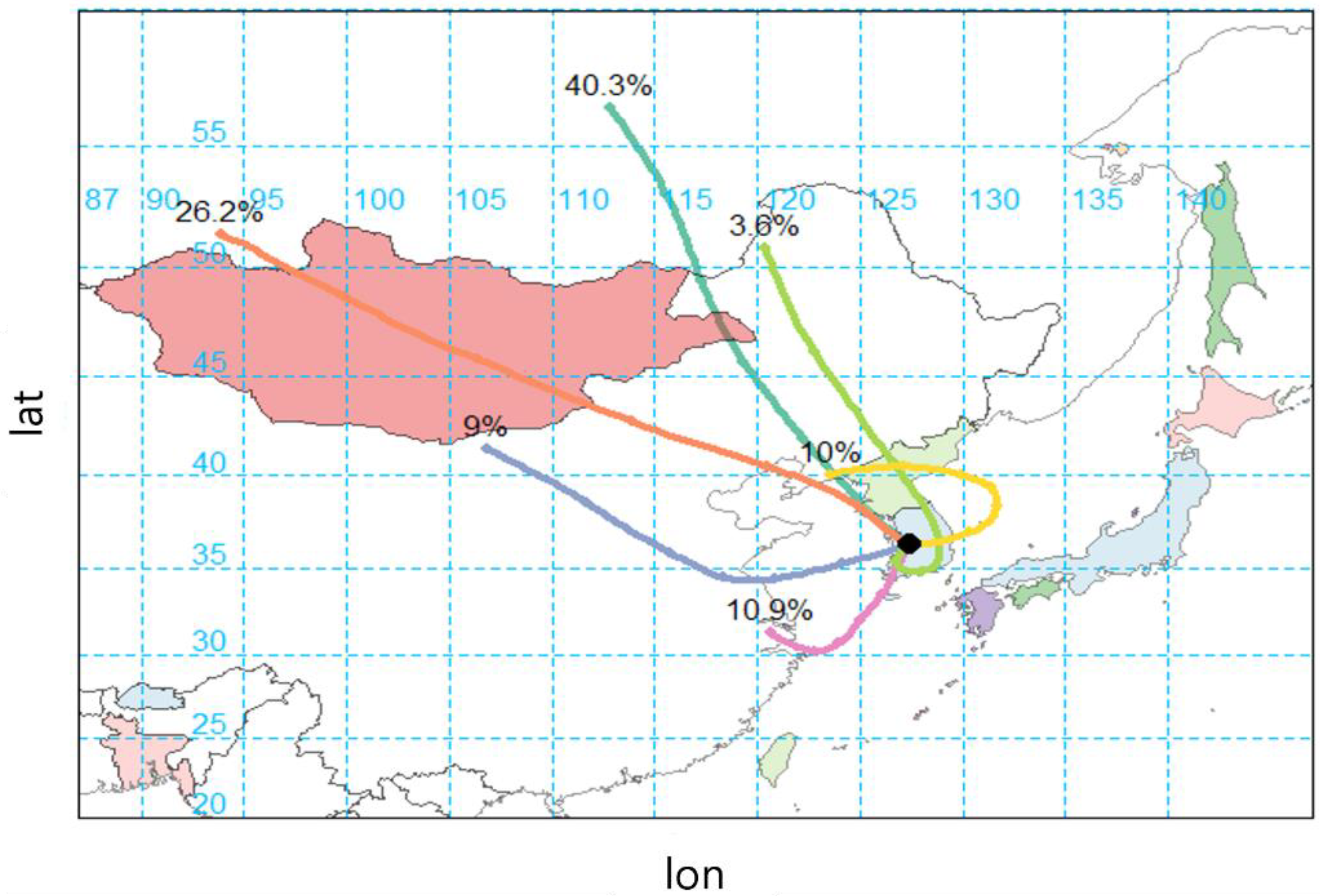
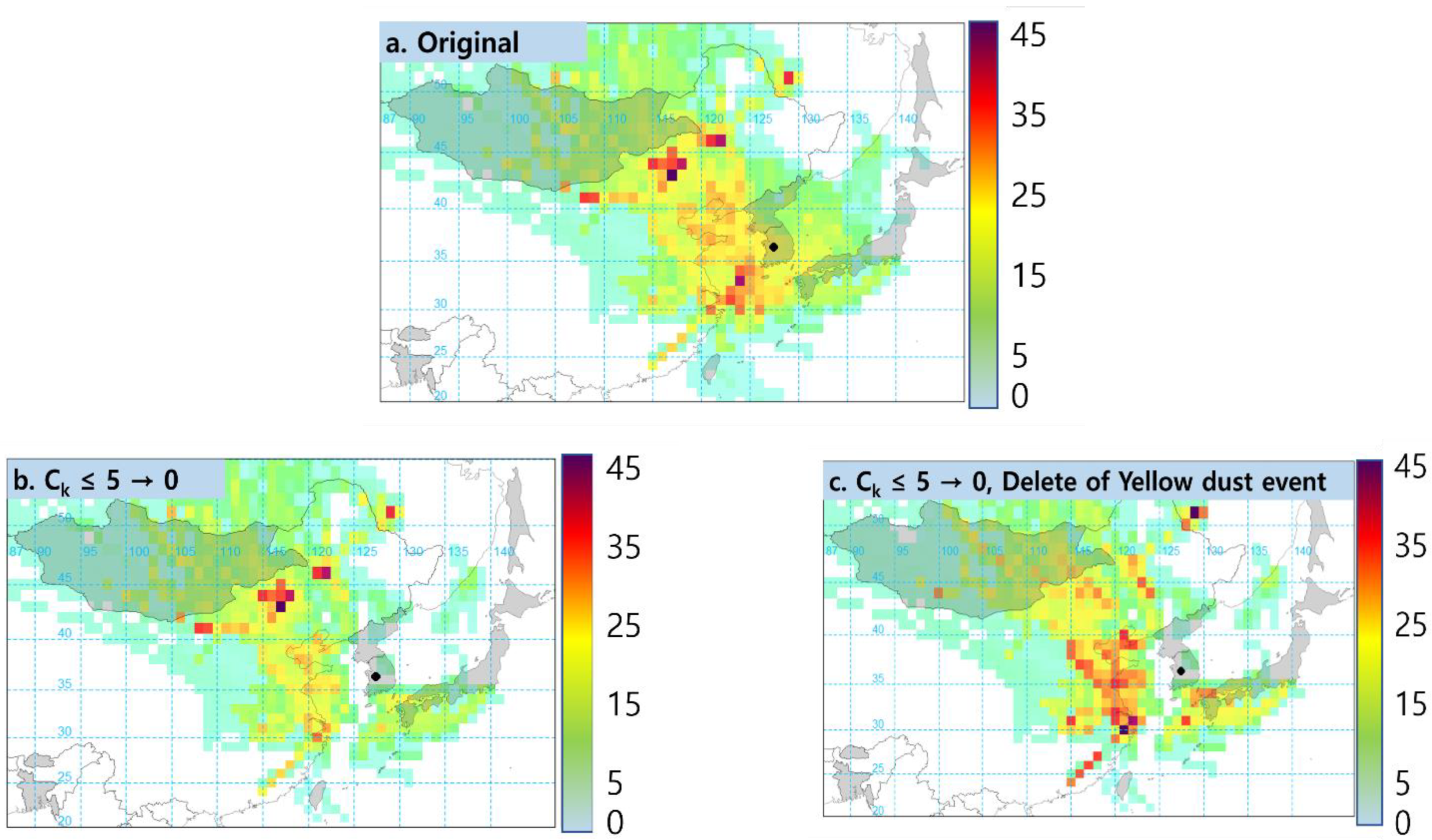
| Source | Contribution | Pie Chart |
|---|---|---|
| Secondary sulfate | 30% |  |
| Secondary nitrate/chloride | 22% | |
| Coal combustion | 5% | |
| Vehicle | 17% | |
| Dust | 16% | |
| Sea salt | 5% | |
| Industry | 5% |
Publisher’s Note: MDPI stays neutral with regard to jurisdictional claims in published maps and institutional affiliations. |
© 2022 by the authors. Licensee MDPI, Basel, Switzerland. This article is an open access article distributed under the terms and conditions of the Creative Commons Attribution (CC BY) license (https://creativecommons.org/licenses/by/4.0/).
Share and Cite
Han, S.-W.; Joo, H.-S.; Song, H.-J.; Lee, S.-B.; Han, J.-S. Source Apportionment of PM2.5 in Daejeon Metropolitan Region during January and May to June 2021 in Korea Using a Hybrid Receptor Model. Atmosphere 2022, 13, 1902. https://doi.org/10.3390/atmos13111902
Han S-W, Joo H-S, Song H-J, Lee S-B, Han J-S. Source Apportionment of PM2.5 in Daejeon Metropolitan Region during January and May to June 2021 in Korea Using a Hybrid Receptor Model. Atmosphere. 2022; 13(11):1902. https://doi.org/10.3390/atmos13111902
Chicago/Turabian StyleHan, Sang-Woo, Hung-Soo Joo, Hui-Jun Song, Su-Bin Lee, and Jin-Seok Han. 2022. "Source Apportionment of PM2.5 in Daejeon Metropolitan Region during January and May to June 2021 in Korea Using a Hybrid Receptor Model" Atmosphere 13, no. 11: 1902. https://doi.org/10.3390/atmos13111902
APA StyleHan, S.-W., Joo, H.-S., Song, H.-J., Lee, S.-B., & Han, J.-S. (2022). Source Apportionment of PM2.5 in Daejeon Metropolitan Region during January and May to June 2021 in Korea Using a Hybrid Receptor Model. Atmosphere, 13(11), 1902. https://doi.org/10.3390/atmos13111902






